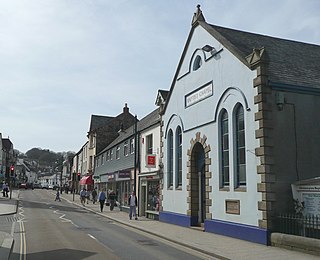
Okehampton is a town and civil parish in West Devon in the English county of Devon. It is situated at the northern edge of Dartmoor, and had a population of 5,922 at the 2011 census. Two electoral wards are based in the town. Their joint population at the same census was 7,500.
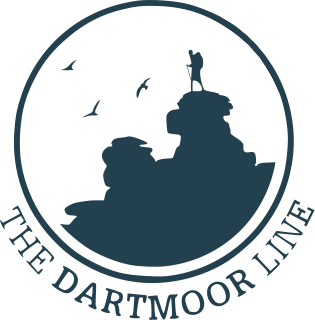
The Dartmoor line is a 15+1⁄2-mile (24.9 km) railway line in Devon, England. From Crediton, the line runs alongside the Tarka Line to the site of the former Coleford Junction where it diverges west to Okehampton. Previously a heritage line, it is owned by Network Rail.

The West of England line is a British railway line from Basingstoke, Hampshire, to Exeter St Davids in Devon, England. Passenger services run between London Waterloo station and Exeter; the line intersects with the Wessex Main Line at Salisbury. Despite its historic title, it is not today's principal route from London to the West of England: Exeter and everywhere further west are reached more quickly from London Paddington via the Reading–Taunton line.

The Tarka Line, also known as the North Devon Line, is a local railway line in Devon, England, linking the city of Exeter with the town of Barnstaple via a number of local villages, operated by Great Western Railway (GWR). The line opened in 1851 from Exeter to Crediton and in 1854 the line was completed through to Barnstaple. The line was taken over by the London and South Western Railway (LSWR) in 1865 and later became part of the Southern Railway and then British Rail. In 2001, following privatisation, Wessex Trains introduced the name Tarka Line after the eponymous character in Henry Williamson's book Tarka the Otter. The line was transferred to First Great Western in 2006.

Exeter St Davids is the principal railway station serving the city of Exeter in Devon, England. It is 193 miles 72 chains from the zero point at London Paddington on the line through Bristol which continues to Plymouth and Penzance. It is also served by an alternative route to London Waterloo via Salisbury and branch lines to Exmouth, Barnstaple, and Okehampton. It is currently managed by Great Western Railway and is served by trains operated by Great Western Railway, South Western Railway and CrossCountry.
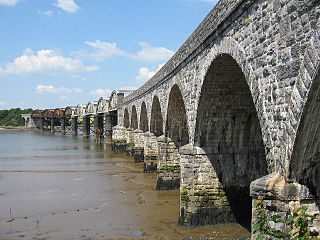
The Plymouth, Devonport and South Western Junction Railway (PD&SWJR) was an English railway company. It constructed a main line railway between Lydford and Devonport, in Devon, England, enabling the London and South Western Railway (LSWR) to reach Plymouth more conveniently than before.

Crediton railway station is a railway station serving the town of Crediton in Devon, England. It is 7 miles 76 chains (12.8 km) from Exeter Central at milepost 179.25 from London Waterloo.

St Budeaux Victoria Road railway station is a suburban station in St Budeaux, Plymouth, Devon, England. The station is managed and served by Great Western Railway.

Okehampton railway station is a terminus railway station on the Dartmoor line serving the town of Okehampton in Devon, England. The station closed to regular traffic in 1972, but heritage and occasional mainline services ran from 1997 to 2019. Regular railway services resumed in November 2021.

Yeoford railway station is a rural station serving the village of Yeoford in Devon, England. It is on the Tarka Line to Barnstaple, 11 miles 42 chains (18.5 km) from Exeter Central at milepost 183 from London Waterloo.
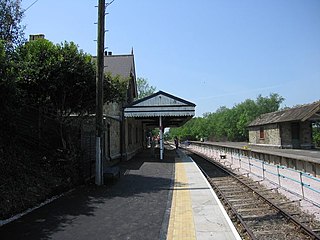
Bere Alston railway station serves the village of Bere Alston in Devon, England, 10+1⁄4 miles (16.5 km) north of Plymouth on the Tamar Valley Line to Gunnislake.

The South Devon and Tavistock Railway linked Plymouth with Tavistock in Devon; it opened in 1859. It was extended by the Launceston and South Devon Railway to Launceston, in Cornwall in 1865. It was a broad gauge line but from 1876 also carried the standard gauge trains of the London and South Western Railway between Lydford and Plymouth: a third rail was provided, making a mixed gauge. In 1892 the whole line was converted to standard gauge only.
The Okehampton–Bude line was a railway line built to serve Holsworthy in Devon, and Bude on the Cornish coast near the Devon border in England. The line branched from the main line at Meldon Junction to the west of Okehampton on the northern edge of Dartmoor. The line opened in 1879 to Holsworthy and in 1898 to Bude. It is now closed.

The Exeter to Plymouth railway of the London and South Western Railway (LSWR) was the westernmost part of a route competing with that of the Great Western Railway (GWR) and its 'associated companies' from London and Exeter to Plymouth in Devon, England. Whereas the GWR route from Exeter followed the coast to Newton Abbot and then went around the southern edge of Dartmoor, the LSWR route followed the northern and western margins of Dartmoor, passing through the towns of Crediton, Okehampton, and Tavistock.

Sampford Courtenay railway station is a disused railway station at Belstone Corner, which used to serve the nearby village of Sampford Courtenay in Devon. The village lies 3 minutes away by car or around 30 minutes by foot via the B3215. In 2018–19 it was the least used station in Devon and in the South West and the tenth least used station in Great Britain. In 2020-21 it was the joint least used station in Great Britain with 0 passengers.

Bow railway station was a railway station serving the village of Bow and the hamlet of Nymet Tracy in Devon. Bow lies about 8 miles west of Crediton.

The Turnchapel Branch was a London and South Western Railway (LSWR) single track branch railway line in Devon, England, that ran from Plymouth Friary station to Turnchapel. It crossed the River Plym and opened up the east side of the river to rail connections. The short line opened in 1892 and 1897 (throughout). It closed in 1951 to passengers, and in 1961 completely.
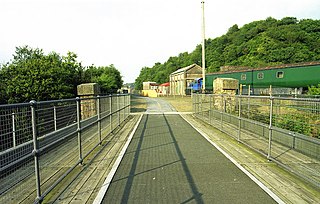
Meldon Viaduct railway station was a railway station at Meldon in Devon. It was renamed in 2015 from Meldon Quarry railway station.

Meldon Quarry is a granite quarry in Devon, England. It is at the northern edge of Dartmoor, about 2 miles SW of Okehampton. It was developed from 1897 to supply track ballast and other stone products for the London and South Western Railway (LSWR). It was privatised in 1994.

Meldon Viaduct carried the London & South Western Railway (LSWR) across the West Okement River at Meldon on Dartmoor in Devon, South West England. The truss bridge, which was constructed from wrought iron and cast iron not stone or brick arches, was built under the direction of the LSWR's chief engineer, WR Galbraith. After taking three years to build, the dual-tracked bridge opened to rail traffic in 1874. Usage was limited to certain classes of locomotive because the viaduct had an axle load limit. Although regular services were withdrawn in 1968, the bridge was used for shunting by a local quarry. In the 1990s the remaining single line was removed after the viaduct was deemed to be too weak to carry rail traffic.




















